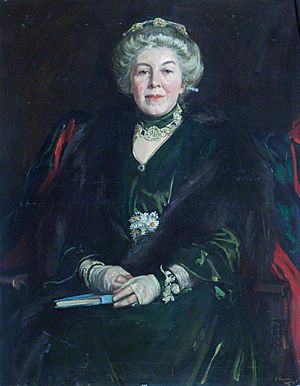Constance Jones facts for kids

Emily Elizabeth Constance Jones (born February 19, 1848 – died April 9, 1922) was an important English thinker and teacher. People often called her Constance Jones. She studied and taught about logic (how we reason) and ethics (what is right and wrong).
Contents
Life and Career
Constance Jones was born in Herefordshire, England, in 1848. She was the oldest of ten children. For most of her childhood, she was taught at home.
When she was a teenager, Constance lived with her family in Cape Town, South Africa. In 1865, they moved back to England. She then went to a small school in Cheltenham for one year.
Studying at Cambridge
Constance wanted to go to Girton College, Cambridge. This was a college for women at University of Cambridge. She studied hard for the entrance exam.
In 1875, she started at Girton. She was very interested in books about economics and logic. So, she chose to study Moral Sciences. This subject included philosophy, economics, and psychology.
Her studies were often interrupted. She had to take care of her aunt. Also, her younger brothers' education was sometimes seen as more important than hers. But even with these challenges, she did very well. In 1880, she earned a first-class degree in Moral Sciences. This was a great achievement!
Working at Girton College
In 1884, Constance returned to Girton College. She became a researcher and a teacher of Moral Sciences. She worked with famous thinkers like Henry Sidgwick.
She helped translate a big book called Mikrokosmus. She also edited some of Henry Sidgwick's books on ethics. Ethics is the study of moral principles.
Constance wrote several of her own books:
- Elements of Logic (1890)
- A Primer of Logic (1905)
- A Primer of Ethics (1909)
- A New Law of Thought and its Logical Bearing (1911)
- Girton College (1913)
From 1903 to 1916, Constance Jones was the Mistress of Girton College, Cambridge. This means she was the head of the college.
Important Contributions
Constance Jones was one of the first women to join the Aristotelian Society in 1892. This was a group for philosophers. She also served on their main committee.
She was the first woman known to give a speech at the Cambridge University Moral Sciences Club. She spoke about a book on December 1, 1899. Her ideas were seen as very original and influenced other thinkers.
She spent her career working on an idea in logic. She believed that statements are made of a subject and a predicate. These parts are connected by being either the same or different.
Philosophy
Constance Jones' most important work was in logic. Many people at the time thought she was an expert in this area. Her main book was A New Law of Thought and its Logical Bearings (1911).
She was very interested in how we understand statements. She wondered what a statement truly means when someone says it. She wrote: "This unsettled question—what is asserted when you make a statement, and what is the proper form of statement?—had deeply interested me from the time when I was a student..."
Constance Jones wrote many textbooks on logic. She also wrote articles about logic and ethics. Even though she made important contributions to analytic philosophy, her work is not as well-known today.
See also
 In Spanish: Constance Jones para niños
In Spanish: Constance Jones para niños

